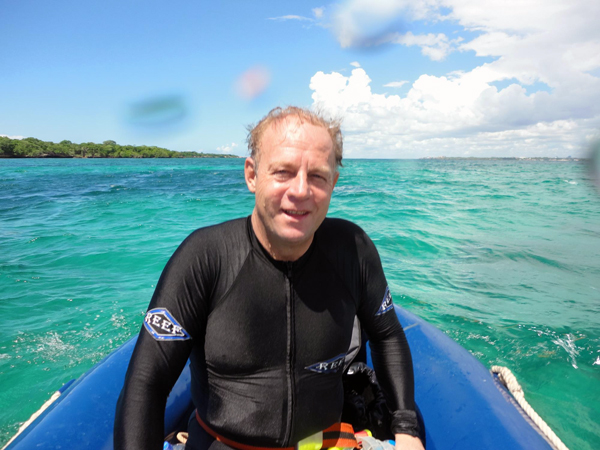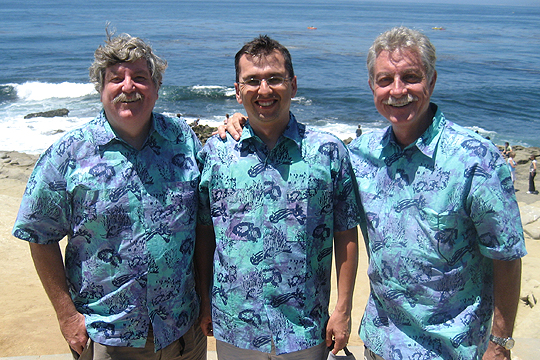 |
Ardeadoris c.f. egretta
Image courtesy of Alan SuttonDar es Salaam in Tanzania
 |
Ardeadoris c.f. egretta or is it? Webmaster Miller handed me this one that came in from Alan Sutton who resides in Tanzania , noting that it had him confused because he had never seen an Ardeadoris egretta, with quite this coloration. The marginal band is thin and reddish, not orange as in the classical case with A. egretta. The gill also possesses reddish color along its margins. The gill of Ardeadoris egretta is pure white. It certainly doesn't fit any of our known species in first edition of NSSI, or the second edition in prep right now to be released this fall. Alan has posted a video of this guy on youtube. Evidently from the video, our unknown can achieve sizes not generally seen in Ardeadoris egretta (at least by our Webmaster). Alan has measured one at 15 cm which is approaching Spanish Dancer dimensions but certainly isn't same. Alan indicates when present, our unk is generally seen around 18 meters. Let's just leave it as "c.f." and see if any of you the reader can shed some light on this one.
Sammamish, WA 98074 April, 2018 Send Dave email at davidwbehrens@gmail.com
|
Alan Sutton on location

I am originally from South Africa, I was born in Durban in 1959 but spent most of my early life and school in Pietermaritzburg. I started diving at an early age, when I was about 4. I saw an article in a magazine with pictures of Jacque Cousteau with a mask on. My father had a pair of old flying goggles and on the next family holiday to the sea I took them with and tried them out. Needless to say they leaked but I got a glimpse of a few fish that I can still remember today. I started free diving a lot in the holidays when I was about 12 years old, diving with my cousins who were into spear fishing and used to dive with the then South African Champions who taught me how to dive. I used to go along and watch. When I was at University in Durban where I studied Law and then Maritime Law, I dived a lot for crayfish, a hobby which I continued until I moved to Dar es Salaam in Tanzania in 1999. I had my first seawater fish tank when I was 16 and kept up the hobby until I moved to Tanzania. In Tanzania I have dived Pemba Island, Zanzibar, Mafia Island, Kilwa and Mtwara all of which have world class diving. I have dived the Kwa-Zulu Natal North and South coasts extensively as well as the Transkei coast and also done some diving in Dahab in Egypt. My favorite dive spot ever is the north east point of Mafia Island. Big drop offs with a strong current and a lot of life ranging from small stuff to large trevally's, dog tooth tuna, very large bass and a few sharks. I only switched across to Scuba about 6 years ago and have done about 500 dives maybe slightly more. I have Padi Rescue Diver and Deep dive qualifications. Usually I dive at least twice a week but sometimes up to six times a week if the conditions are good. I mainly dive with the Dar es Salaam Yacht Club , we have a dedicated dive boat and have 7 scheduled dives a week. We dive in the vicinity of Dar es Salaam either just north which has some good walls or just to the south which has some wrecks. |
I have a blog called seaunseen.com that I and a friend have as a hobby and the aim is to try to document the sea life in Tanzania. For years the Tanzanian coast has suffered from dynamite fishing but since November 2017 the Government have had a clampdown on it and it seems to have completely stopped. In the short space of time since November the fish life is rebounding amazingly well and I think we will have some world class diving in about three years time around Dar es Salaam. Visibility in Dar es Salaam varies from about 5 meters to up to at least 30 meters. On the the islands Pemba, Zanzibar and Mafia which have no rivers per se on them , in the right season visibility can be as good as it is possible to get with salt water.
I first found a cf. egretta in early 2016 on a night dive, initially I assumed it was a Ardeadoris symmetrica but the rhinophores and gills were the wrong color. In 2016 and early 2017 I found several very large specimens which I managed to video. The largest was about 14 - 15 cm in length and about 3cm in height and up to 4 cm in width. I had an argument with one of the fellow divers who was adamant that it was so large it had to be a Spanish Dancer, Hexabranchus sanguineus. So they seem to grow much larger than the other Nudibranchs with the exception of the Spanish Dancer and some of the Dendrodoris. During 2017 I saw several more specimens but so far in 2018 I have not sighted any. Other divers from the Yacht Club have though.
Send Alan email at alan@robmarine.com

|
